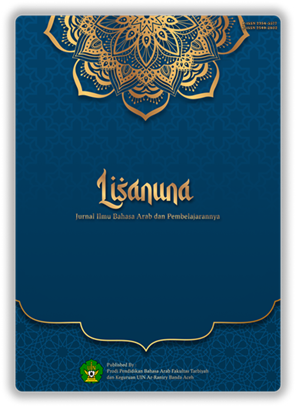تأثير استخدام وسيلة صندوق القراءة على مهارة القراءة الطّلّاب بمدرسة الثّانويّة الحكوميّة ۲ بادنج بنجانج
DOI:
https://doi.org/10.22373/ls.v13i1.18054Keywords:
Arabic learning, reading box, Arabic reading skillsAbstract
There are several problems in learning Arabic, namely the teacher does not use different learning media in teaching, especially in reading skills. It will be more interesting if the teacher is creative in using different media, so that it can increase students' enthusiasm and motivate them in learning. The problem is, teachers still have difficulty developing many Arabic learning media that suit the needs of students. The researcher decided to examine the effect of reading box media (a different method than usual) on students' reading abilities. Researchers use experimental research methods because researchers will look for the effect of certain treatments on others in the subjects held. This means looking for the effect of using reading box media on students' reading skills. The number of the research community consisted of 17 students, and the researchers took a random sample in this thesis, namely 17 students. Then the research instrument is observation, test. The researcher used reading box media in the experimental class to understand the text of reading skills in eleventh grade Arabic lessons well and fluently with an average score of 87.76, and in the control class with an average score of 80.06. . The result of calculating T (2.263) is greater than T table (2.037). The researcher concludes that the null hypothesis is rejected and the alternative hypothesis is accepted.References
أ. المراجع العربية
أزهار, محمّد يحيى. تنميّة تعليم مهارة القراءة باستخدام طريقة القراءة. مالانج: جامعة مولانا مالك إبراهيم الإسلاميّة الحكوميّة بمالانج.
ابراهيم, الخطيبمحمّد بن. طرائق تعليم اللّغة العربيّة. الرّياض: مكتبة التّوبة.
الدين, عبد الحميد شمس. تعريف القراءة. في أكبر موقع عربي بالعالم, 2021.
جيدير, ماثيو. منهجية البحث. الفرنسية: ملكة أبيض, مجهول السّنة.
طعيمة, رشدي أمحد. “تعليم العربيّة لغري النّاطقني هبا مناهيه و أساليبه.” جامعة املنصورة: إيسيسكو.
عيدات, ذوقان. “البحث العلمي: مفهومه- أدواته- أساليّة.” عثمان: دار الفكر لنشر والتّوزيع..
مهبارة, بيضاءسيدة. “أهمّيّة الوسائل التّعليميّة في تدريس اللّغة العربيّة لغير النّاطقين بها.” KONASBARA.
يونس, فتح على. اساسيات تعليم اللّغة العربيّة والتّربيّة الدّينيّة. قاهرة: دار الثقافة
ب. المراجع الإندونيسية
Arikunto, Suharsimi. Prosedur Penelitian Suatu Pendekatan Praktik. XIII. Jakarta: PT Reka Cipta, 2006.
Hamalik. Media Pendidikan. Bandung: PT Citra Aditya Bakti, 1994.
Lismay, Leli, and Zubaidah. “Strategi Pembelajaran Bahasa Inggris Mahasiswa Mahad IAIN Bukittinggi.” Journal Educative: Journal of Educational studies 4 (2019): 48.
Marzuki, Saleh. Pendidikan Nonformal. Bandung: PT Remaja Rosdakarya, 2012.
Muhajir, As’aril. Ilmu Pendidikan Perspektif Kontekstual. yogyakarta: Ar-Ruzz Media, 2011.
Mujis, Daniel. “Doing Quantitative Research in Education With SPSS.” First Publish: London Sage Publication (2004).
Prihartini, Yogia, Wahyudi Buska, and Nur Hasnah. “The Implementasion of Suggestopedia Method in Arabic Teaching for Qiraah.” Journal for Religious-Innovation studies XIX (2019): 31.
Rosyidi, Abdul Wahab. Media Pembelajaran Bahasa Arab. Malang: UIN Malang Press, 2009.
Sadiman, Arief, and Dkk. Media Pendidikan. Jakarta: PT Raja Grafindo Persada, 2012.
Setiawati, Sulis. Penggunaan Media Reading Box Dalam Pembelajaran Bahasa Indonesia Berbasis Teks. Jakarta: Universitas Indraprasta PGRI, 2018.
Soeparno. Alat Peraga Pendidikan. Jakarta: CV, 1987.
Sudarsana, Undang, and Bastiono. Pembinaan Minat Baca. Jakarta: Universitas Terbuka, 2010.
Sugiono. Statistika Untuk Penelitian. Bandung: Alfabeta, 2014.
Susilana, and Cepi Riyana. Media Pembelajaran. Bandung: CV, 2009.
Umarella, Samad, M. Sahrawi Saimima, and Saddan Husein. “Urgensi Media Dalam Proses Pembelajaran.” Jurnal IAIN Ambon AL-ILTIZAM 3 (2018)
Downloads
Published
Issue
Section
License
1. Proposed Policy for Journals That Offer Open Access Authors who publish with this journal agree to the following terms:
1.a. Authors retain copyright and grant the journal right of first publication with the work simultaneously licensed under a Creative Commons Attribution License that allows others to share the work with an acknowledgement of the work's authorship and initial publication in this journal.
1.b. Authors are able to enter into separate, additional contractual arrangements for the non-exclusive distribution of the journal's published version of the work (e.g., post it to an institutional repository or publish it in a book), with an acknowledgement of its initial publication in this journal.
1.c. Authors are permitted and encouraged to post their work online (e.g., in institutional repositories or on their website) prior to and during the submission process, as it can lead to productive exchanges, as well as earlier and greater citation of published work (See The Effect of Open Access).
2. Proposed Policy for Journals That Offer Delayed Open Access Authors who publish with this journal agree to the following terms:
2.a. Authors retain copyright and grant the journal right of first publication, with the work [SPECIFY PERIOD OF TIME] after publication simultaneously licensed under a Creative Commons Attribution License that allows others to share the work with an acknowledgement of the work's authorship and initial publication in this journal.
2.b. Authors are able to enter into separate, additional contractual arrangements for the non-exclusive distribution of the journal's published version of the work (e.g., post it to an institutional repository or publish it in a book), with an acknowledgement of its initial publication in this journal.
2.c. Authors are permitted and encouraged to post their work online (e.g., in institutional repositories or on their website) prior to and during the submission process, as it can lead to productive exchanges, as well as earlier and greater citation of published work (See The Effect of Open Access).

